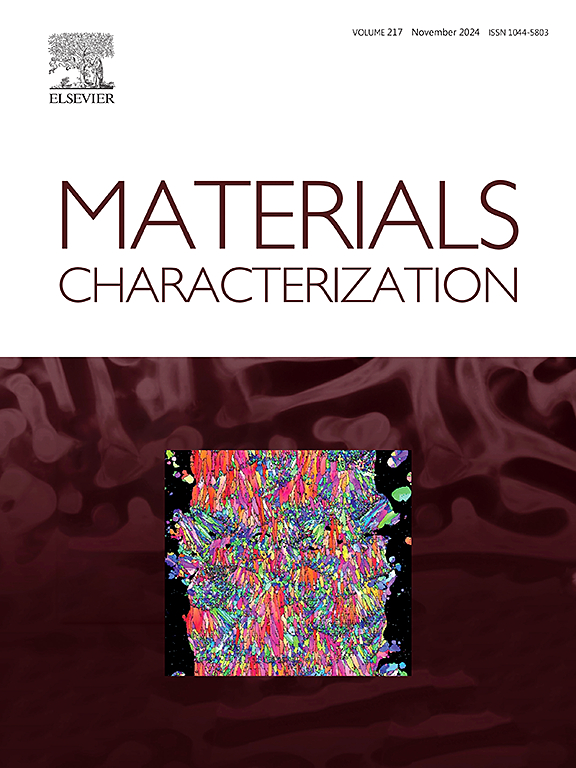The thermal stability, phase precipitation and tribological behavior of AlCoCrFeNb0.4Ni2.1 multiphase high entropy alloy under heat treatment
IF 4.8
2区 材料科学
Q1 MATERIALS SCIENCE, CHARACTERIZATION & TESTING
引用次数: 0
Abstract
For AlCoCrFeNb0.4Ni2.1 high entropy alloy samples subjected to vacuum heat treatment, the effects of temperature on microstructure and tribological performance were investigated. The results indicate that the samples exhibit considerable thermal stability, the phase structure does not change before and after heat treatment, and is composed of the FCC phase, the BCC phase, and the (Ni, Cr, Co, Fe)₂Nb-type Laves phase. The heat treatment accelerates the precipitation of the FCC phase within the BCC phase, with the precipitation rate increasing as the temperature rises. When the temperature reaches 800 °C, the Laves phase begins to precipitate in the BCC phases. After 700 °C-2 h heat treatment, the AlCoCrFeNb0.4Ni2.1 HEA samples attain the highest microhardness and the best wear resistance. As the heat treatment temperature increases, the wear mechanism is gradually dominated by oxidative wear and adhesive wear. In summary, the multiphase HEA prepared by appropriate ratio and process has reliable microhardness and wear resistance, and after 700 °C-2 h heat treatment, the content of each phase reaches the best ratio, making HEA not only have strong wear resistance, but also reduce the friction coefficient, which provides a design idea for the subsequent design of strengthening and toughening metal.
热处理下AlCoCrFeNb0.4Ni2.1多相高熵合金的热稳定性、相析出及摩擦学行为
对真空热处理的AlCoCrFeNb0.4Ni2.1高熵合金试样,研究了温度对其显微组织和摩擦学性能的影响。结果表明:样品具有较好的热稳定性,热处理前后相结构基本不变,主要由FCC相、BCC相和(Ni, Cr, Co, Fe) 2 nb型Laves相组成。热处理加速了BCC相内FCC相的析出,随着温度的升高,析出速率增大。当温度达到800℃时,Laves相开始在BCC相中析出。经过700°C-2 h热处理后,AlCoCrFeNb0.4Ni2.1 HEA样品的显微硬度最高,耐磨性最好。随着热处理温度的升高,磨损机制逐渐以氧化磨损和粘着磨损为主。综上所述,采用适当配比和工艺制备的多相HEA具有可靠的显微硬度和耐磨性,且经过700℃-2 h热处理后,各相含量达到最佳配比,使得HEA不仅具有较强的耐磨性,而且摩擦系数降低,为后续金属强化增韧设计提供了设计思路。
本文章由计算机程序翻译,如有差异,请以英文原文为准。
求助全文
约1分钟内获得全文
求助全文
来源期刊

Materials Characterization
工程技术-材料科学:表征与测试
CiteScore
7.60
自引率
8.50%
发文量
746
审稿时长
36 days
期刊介绍:
Materials Characterization features original articles and state-of-the-art reviews on theoretical and practical aspects of the structure and behaviour of materials.
The Journal focuses on all characterization techniques, including all forms of microscopy (light, electron, acoustic, etc.,) and analysis (especially microanalysis and surface analytical techniques). Developments in both this wide range of techniques and their application to the quantification of the microstructure of materials are essential facets of the Journal.
The Journal provides the Materials Scientist/Engineer with up-to-date information on many types of materials with an underlying theme of explaining the behavior of materials using novel approaches. Materials covered by the journal include:
Metals & Alloys
Ceramics
Nanomaterials
Biomedical materials
Optical materials
Composites
Natural Materials.
 求助内容:
求助内容: 应助结果提醒方式:
应助结果提醒方式:


